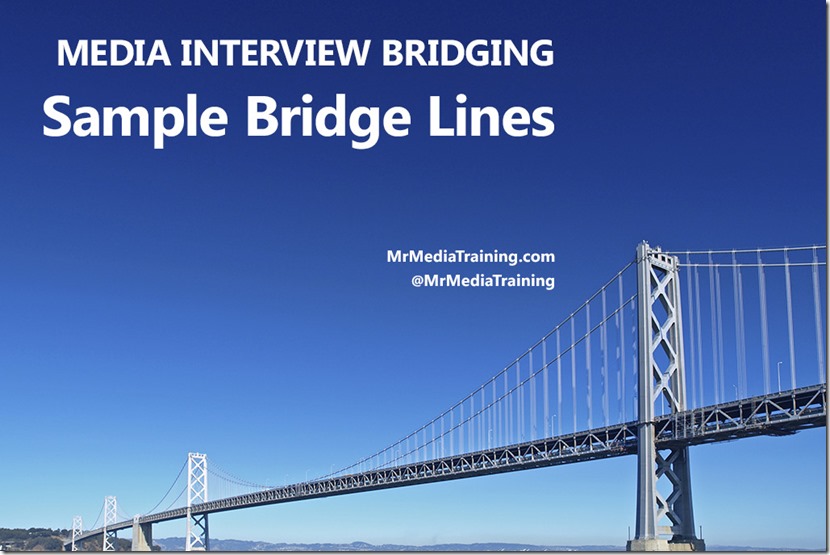Media Interview Bridging: Sample Bridge Lines
In the first part of this series, I defined what “bridging” is, showed you how to bridge during a media interview, and explained when you should do so.
In this post, you’ll find a list of 17 bridge lines. I suggest that you take a look at them, find a couple you’d be most comfortable using, and store them in memory before your next interview.

Sample Bridge Lines
- “It’s important to remember that …”
- “Keep in mind that …”
- “Here’s what we’ve been hearing from our members …”
- “Let me tell you what we’ve been seeing …”
- “I’m not sure that’s the case …”
- “However …”
- “That said …”
- “Here’s what we know …”
- “But even more importantly …”
- “If your listeners keep only one thing in mind, it’s that …”
- “What we see as an even bigger issue is …”
- “The thing we are focusing on most is …”
- “We view that as an incomplete view of the issue. The fuller view is that …”
- “I wouldn’t say that. What I would say is that …”
- “What our research shows is…”
- “Let me put that in context.”
- “That’s a common misperception, so I’m glad you brought that up.”
Stay tuned for Part Three of this series.



Questions. Your list doesn’t include questions, and (rhetorical) questions are a great way to bridge, in my humble opinion.
– and how can we best do that?
– but what does it really mean?
– but what is the other side of the issue?
– but would that work?
– what else do we need to pay attention to?
– and what have we found?
– but how would that be possible?
– …
You receive the reporter’s question content positively, then ask yourself a new question to bridge, then answer with your message.
Great content ! It is very relevant to be prepared to build bridges , especially when the question was asked of mistaken or biased manner.
I caution clients about questioning reporters when in media conferences. It can lead to one-on-one combat with a particular reporter, and can come across as aggressive. After all, most reporters are usually asking challenging questions to test the subject’s knowledge or point of view (playing the devil’s advocate), often using the argument of an opponent – they don’t necessarily hold the view themselves. I recommend a bridge such as: “some people may think that but my point is …”
@Hugh, if I understand correctly it seems your advice is directed at my suggestion of using questions; and although I think your advice is good advice in general, I must clarify that it doesn’t really address my suggestion – I clearly state that these questions are rhetorical, and to be immediately answered by yourself… I am not recommending questions to the reporter.
It is just a mode of speech. It gives a certain appearance of dialogue, without being dialogue. I find they are one of the most natural ways of connecting to pieces of thought, of moving on to a different idea.